The narrow winding two-lane from Capulin Volcano to Folsom Falls and down to where Toll Gate Canyon meets the Dry Cimarron River valley runs the odometer up about 16 miles. From the Jeffers Ranch, a crawling line of horsemen can be spotted inching down the steep mountainside from Emery Peak. They’ve shunned the road, crossing a mesa and several ranches. When they reach the valley floor to camp at Jeffers, in the northeastern corner of New Mexico, their GPS unit will say they’ve traveled 14.2 miles in seven hours.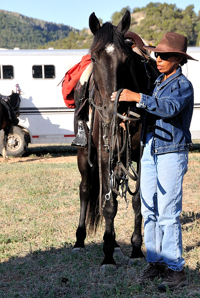
Freda Jackson, right, a medical secretary from White Post, Virginia, was a little scared. “Only a seasoned horseman would be comfortable coming down that mountain,” she says. “They know their horses, they know their skills. My horse knows nothing like that.” With some guidance from trail boss Hayward Simmons, of Allendale County, South Carolina, Jackson and her black Tennessee Walker, Ace, made it to the Jeffers Ranch safe, sound, and happy.
Jackson and Simmons are among a group of some four dozen riders who set out April 21 from a remote stretch of Mexican border to spend four-and-a-half months crossing America on horseback, all the way to the Canadian border. Organized by an RFD-TV satellite TV show called “Best of America by Horseback”, host Tom Seay and his wife, director/producer Pat Seay, plotted the route last year – first by map in their Virginia home, then by Google. In October, they drove the route, cleaving to back roads and paths, noting ranchers’ names on mailboxes, stopping by isolated post offices.
“One person leads to another,” says Tom, 58. “It’s your classic networking. We meet one rancher, then he calls his neighbor. They’re all excited to help. They guide us through, so we often manage to avoid even the little county roads.” Simmons adds, “Everyone’s been amazing. They want to help, and they want to show you their place.”
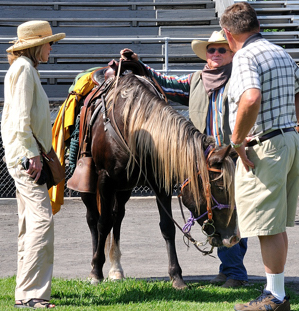 Simmons, 59, center left, leads the riders north each morning at 7:30. They ride 16-20 miles, averaging 3 1/2 miles an hour, stopping at a pre-arranged spot in mid-afternoon. The Seays have assembled a staff that plans the route and logistics, shuttling the riders back to where they left their horse trailers in the morning. The riders bring their trailers along, using roads they’ve bypassed earlier in the day.
Simmons, 59, center left, leads the riders north each morning at 7:30. They ride 16-20 miles, averaging 3 1/2 miles an hour, stopping at a pre-arranged spot in mid-afternoon. The Seays have assembled a staff that plans the route and logistics, shuttling the riders back to where they left their horse trailers in the morning. The riders bring their trailers along, using roads they’ve bypassed earlier in the day.
These aren’t simple horse trailers: they’re elaborate “coach trailers” that combine roomy recreational vehicle quarters and amenities with a horse trailer in back. They’re gooseneck trailers pulled by big American 4-wheel drive pickup trucks. After pulling into the Jeffers Ranch in a caravan of these rigs, 63-year-old Bobby Horton has cleaned up and is enjoying the shade of a big juniper tree next to his trailer. Owner of Big River Grain Company in Cleveland, Mississippi, Horton has pondered the total value of the three dozen or so trucks and their trailers spread out over a quarter mile here. He came up with a figure of two million dollars.
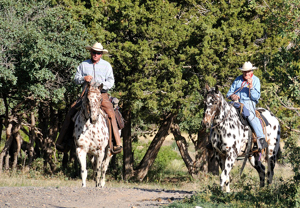
If any of these people are rich, you can’t tell it on the trail. Obviously they’re not poor. Nor young. Most riders are in their 50s, 60s, or 70s. The oldest is Nate Brown, 88, far right, who rides one of his two Appaloosas, Concho and Poncho, every day. Delayed by a broken leg, he joined the ride late, on June 4, dropped off by his wife, 50; he plans to make it to Canada. He’s had horses all his life, at home in Grass Creek, Wyoming, but his trail ride experience has been limited to his home state’s annual week-long Outlaw Trail Ride, which he’s done five times.
“My wife’s gone on to Kentucky,” Brown says, “to help her dad. He’s getting a little age on him. I’ve got my friend from Arizona to help me this week, then another friend’s coming over from Hawaii. Then my wife’s hoping to be back to join me.” Back home, he’s left Katie, a young British woman “between high school and college,” to care for the 80 horses he’s left behind. “I’ve always been a horse nut,” he says.
Most of the riders drove west to join up – from Texas, Georgia, the Carolinas, Virginia, Kentucky, Michigan, Indiana, New Hampshire. Pat Seay says that the 51 riders camped at the Jeffers Ranch represent 36 states. She’s sent letters to horse councils in the other 14 states hoping to grow that number to 50 before they reach the Saskatchewan border around Labor Day.
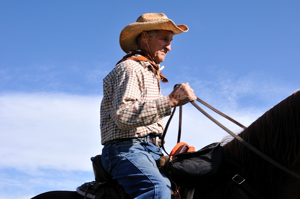 The diversity among the riders is impressive. They like to say they’ve got everything from a rocket scientist to hog farmers. Rich McTasney of Jamestown, Tennessee, is the former NASA contractor. Wayne, left, and Sandy Gifford of Onondaga, Michigan, are the “semi-retired” hog farmers: they used to sell 4000 hogs annually. “We haven’t had a vacation since we got married,” says Sandy. “We’re celebrating our 50th anniversary on this trip. We wanted to do something special. This is it.” Sandy’s e-mail name is pigmamma.
The diversity among the riders is impressive. They like to say they’ve got everything from a rocket scientist to hog farmers. Rich McTasney of Jamestown, Tennessee, is the former NASA contractor. Wayne, left, and Sandy Gifford of Onondaga, Michigan, are the “semi-retired” hog farmers: they used to sell 4000 hogs annually. “We haven’t had a vacation since we got married,” says Sandy. “We’re celebrating our 50th anniversary on this trip. We wanted to do something special. This is it.” Sandy’s e-mail name is pigmamma.
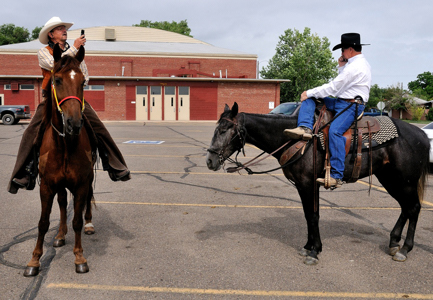 Yes, most of the riders have e-mail and cell phones, though they sometimes go a week between cell signals. Before they join an annual community parade in Swink, Colorado, one Saturday morning, four mounted riders are spotted taking advantage of the cell signal they’ve found in the high school parking lot. “Best of America by Horseback” CEO Mark Laney, 62, a lawyer from Hale Center, Texas, has a satellite connection in his motor home, which he uses to stay in daily contact with their offices in Texas, Virginia, and company headquarters in Leatherwood Mountains, North Carolina. From there, the website bestofamericabyhorseback.com is updated regularly with new route details, photos, stories, and riders’ blogs. Mark and his wife Brenda, also 62, ride two of the five mules on the ride.
Yes, most of the riders have e-mail and cell phones, though they sometimes go a week between cell signals. Before they join an annual community parade in Swink, Colorado, one Saturday morning, four mounted riders are spotted taking advantage of the cell signal they’ve found in the high school parking lot. “Best of America by Horseback” CEO Mark Laney, 62, a lawyer from Hale Center, Texas, has a satellite connection in his motor home, which he uses to stay in daily contact with their offices in Texas, Virginia, and company headquarters in Leatherwood Mountains, North Carolina. From there, the website bestofamericabyhorseback.com is updated regularly with new route details, photos, stories, and riders’ blogs. Mark and his wife Brenda, also 62, ride two of the five mules on the ride.
One of the bloggers is Nancy Kacvinski, 69, below right. She retired nine years ago from her position as network manager for the City of Tampa, Florida, where she oversaw installation of wiring and fiber optic cable along with servers, routers, PCs, and printers. She and her husband Duke sold their Florida property and traveled the country with their coach trailer and two horses. “We were ‘homeless’ for over two years,” Kacvinski says. “Then we bought a ranch and settled in east Texas.” Home in Palestine, Texas, she works out at the Y and likes to dance – she’s a clogger. For now, though, she’s left her husband home to tend their cows and calves while she spends months crossing America on her Quarter Horses, Cisco and 2-Bits.
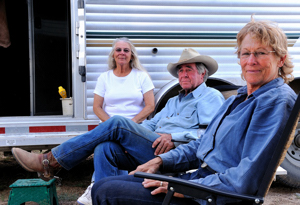 “I keep looking for trail rides,” Kacvinski says. “I found this one on the Internet and it sparked my interest.” As shadows lengthen from the juniper trees on the Jeffers Ranch, she reflects, “I like riding my horse. I like being outdoors. I like the challenge, the adventure, and the people here.” Mississippian Bobby Horton, center, joins in. He says he’s loved and owned horses all his life. “I had ridden with Tom Seay once before, for a week up in Tennessee. I was pleased with what I saw that time. I think I found him through an article in Trail Rider magazine.”
“I keep looking for trail rides,” Kacvinski says. “I found this one on the Internet and it sparked my interest.” As shadows lengthen from the juniper trees on the Jeffers Ranch, she reflects, “I like riding my horse. I like being outdoors. I like the challenge, the adventure, and the people here.” Mississippian Bobby Horton, center, joins in. He says he’s loved and owned horses all his life. “I had ridden with Tom Seay once before, for a week up in Tennessee. I was pleased with what I saw that time. I think I found him through an article in Trail Rider magazine.”
“This is not a cakewalk,” Horton continues. “We get up at 4:30 to feed our horses, feed ourselves. We ride about seven hours most days, then we have to go back and get our rigs.” Kacvinski interjects, “Look at our trucks and trailers, look at the mud.” They were pummeled by a hailstorm three days ago. “It’s not about beauty,” she laughs, “it’s about endurance.”
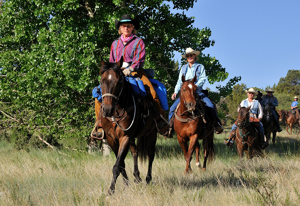
The Jeffers Ranch sits just below the Colorado border. As the riders depart New Mexico, they’ve already covered one-third of the 1800 miles between Mexico and Canada. They’ll cross Colorado, Nebraska, and the Dakotas. Riders come and go, joining for a week or longer. Kacvinski and Horton are among nine “core riders” who won’t miss a step of the route, joining at the Mexico border fence and planning to step onto Canadian soil.
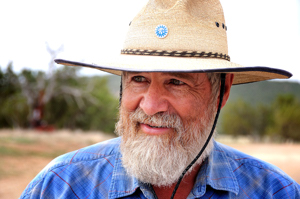 Another core rider is Mike Shaw, 57, a bearded former semi-pro football player from outside Logansport, Indiana. Shaw’s horse was bitten by a rattlesnake a few days ago, its leg swollen bigger than a football. Shaw saw his chances evaporate for riding the full distance. Then Liz Malcome, 70, was bucked off her horse, Champ, suffering a broken wrist and painful shoulder. “He’s a good horse,” Malcome says. “He was just really frisky that morning. He had about eight jumps and I lasted about four. They tell me I almost stayed on eight seconds.”
Another core rider is Mike Shaw, 57, a bearded former semi-pro football player from outside Logansport, Indiana. Shaw’s horse was bitten by a rattlesnake a few days ago, its leg swollen bigger than a football. Shaw saw his chances evaporate for riding the full distance. Then Liz Malcome, 70, was bucked off her horse, Champ, suffering a broken wrist and painful shoulder. “He’s a good horse,” Malcome says. “He was just really frisky that morning. He had about eight jumps and I lasted about four. They tell me I almost stayed on eight seconds.”
Malcome will drive along with the trail ride until she’s ready to remount Champ in about four weeks. That’s how long it’ll take for Mike Shaw’s horse to fully recover from its rattlesnake bite. Meantime, Shaw is riding Champ. The first thing he did was trailer back to where the snake bit his horse. He caught up with the others from there, still able to say he’s ridden every step of the way from Mexico to Canada.
They ride for three or four days, then take a day or two off. They arrive at the Jeffers Ranch on a Friday afternoon, departing to cross the Colorado border near Branson on Sunday morning. Saturday is spent relaxing, visiting, catching up on chores. Several pickup trucks make supply runs to Raton, New Mexico, or Trinidad, Colorado, where the riders stock up on supplies at “Wally World” – Wal-Mart.
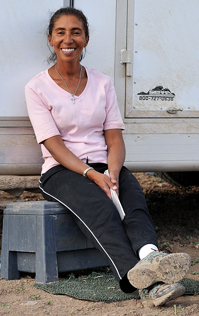 Freda Jackson, 53, sits alone reading a People Magazine on the step of her trailer. Ace, her Tennessee Walker, stands nearby in a portable ring. Both look serene. “I’m here to ride my horse, meet new people, learn better horse skills, and refresh myself,” Jackson says. She rode horses during high school, then not again for 30 years. She returned to riding in 2004.
Freda Jackson, 53, sits alone reading a People Magazine on the step of her trailer. Ace, her Tennessee Walker, stands nearby in a portable ring. Both look serene. “I’m here to ride my horse, meet new people, learn better horse skills, and refresh myself,” Jackson says. She rode horses during high school, then not again for 30 years. She returned to riding in 2004.
“I’m learning a lot of skills here,” she says. “How they ride, rope skills. They’ve shown me simple ways to care for my horses.” A per diem employee on leave from Valley Health at Warren Memorial Hospital’s Lynn Care Center in Virginia, Jackson says, “I love my job”; in fact, she says it three times. Working around rehab patients in long-term care, she reflects, “People are working all the time. They don’t do anything for themselves. They’re having anxiety attacks, strokes, and heart attacks.
“You have to plan for tomorrow, but as much as possible it’s important to do things today that nourish your soul.”
So she’s come out west with Ace and her rescue boxer, Sarge, to ride the entire route from Mexico to Canada. What she shares with the other riders is a love of horses. Beyond that, their life stories reveal little in common. And yet, wandering around talking with the riders as they relax and visit at the Jeffers Ranch, they seem more alike than different. They’ve been together for weeks, weathered by sun and wind, bonded by the camaraderie of riding together for long days, day in and day out.
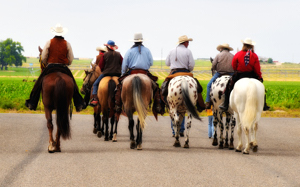
One more thing. Though their life stories sound normal enough, these people are adventurers. They share something with Lewis and Clark, with Kit Carson. These are normal Americans from disparate backgrounds who just happen to be traversing the entire country, from Mexico to Canada, in the year 2009, on horseback. Shunning even the county dirt roads, they’re crossing the America that used to be, and finding a wide-open America that still is. That America is still there, and people are crossing it on horseback.
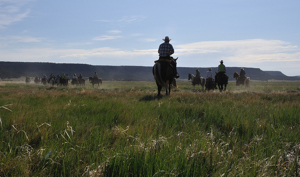
© 2009, 2010 Tim Keller